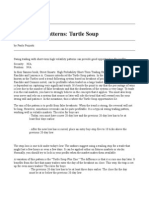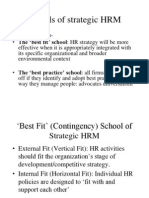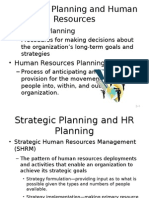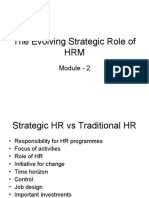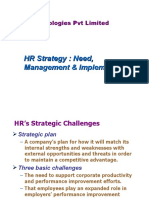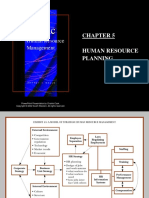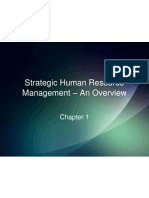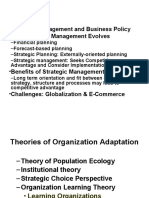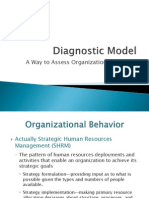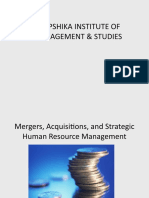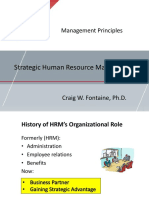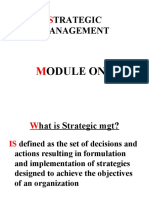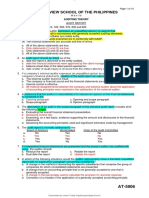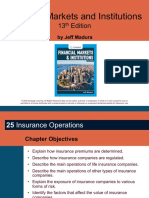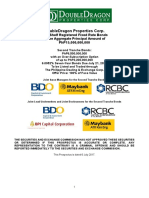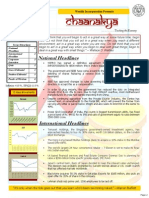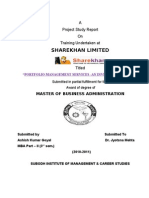CH 03
CH 03
Uploaded by
Mohammad EhsanCopyright:
Available Formats
CH 03
CH 03
Uploaded by
Mohammad EhsanOriginal Title
Copyright
Available Formats
Share this document
Did you find this document useful?
Is this content inappropriate?
Copyright:
Available Formats
CH 03
CH 03
Uploaded by
Mohammad EhsanCopyright:
Available Formats
CHAPTER 3
STRATEGIC
PLANNING
PowerPoint Presentation by Charlie Cook
Copyright © 2002 South-Western. All rights reserved
Strategic Management
• Strategic Human Resource Management
– Involves aligning initiatives involving how people are managed
with the organizational mission and objectives.
• Strategic Management Process
– Determining what needs to be done (how) to achieve
corporate objectives over a three- to five year time span.
– Examining the organization and the competitive environment.
– Establishing a strategic (optimal) “fit” between the organization
and its environment that engenders success.
– Reviewing and revising the strategic plan as necessary.
Copyright © 2002 South-Western. All rights reserved. 3–2
Models of Strategy
• Industrial Organization (O/I) Model
– The external environment is the primary determinant of
organizational strategy rather than the internal decisions of its
managers.
– The environment presents threats and opportunities.
– All competing organizations control or have equal access to
resources.
– Resources are highly mobile between firms.
– Organizational success is achieved by offering goods and
services at lower costs than competitors or by differentiating
products such that they bring premium prices.
Copyright © 2002 South-Western. All rights reserved. 3–3
Models of Strategy (cont’d)
• Resource-Based View (RBV)
– An organization’s resources and capabilities, not external
environmental conditions, should be the basis for strategic
decisions.
– Competitive advantage is gained through the acquisition and
value of organizational resources.
– Organizations can identify, locate and acquire key valuable
resources.
– Resources are not highly mobile across organizations and
once acquired are retained.
– Valuable resources are costly to imitate and non-substitutable.
Copyright © 2002 South-Western. All rights reserved. 3–4
Copyright © 2002 South-Western. All rights reserved. 3–5
The Mission Statement
Copyright © 2002 South-Western. All rights reserved. 3–6
Corporate Strategies: Growth
• Benefits • Internal Methods
– Gaining economies of scale in – Penetration of existing markets
operations and functions – Developing new markets
– Enhancing competitive position – Developing new products or
vis-à-vis industry competitors services for existing or new
– Providing opportunities for markets
employee professional • External Methods
development and advancement
– Acquiring other organizations
• HR Issues – Vertical integration
– Planning for new hiring
• HR Issues
– Alerting current employees
– Merging organizations
– Ensuring quality and
performance standards are – Dismissing redundant employees
maintained
Copyright © 2002 South-Western. All rights reserved. 3–7
Corporate Strategies (cont’d)
• Stability
– Maintaining the status quo due to limited environmental
opportunities for gaining competitive advantage.
– Few employees will have opportunities for advancement.
– Critical that management identify key employees and develop
specific HR retention strategies to keep them.
• Turnaround or Retrenchment
– Downsizing or streamlining the organization in a cost-cutting
attempt to adjust to the competitive environment.
– Few opportunities and many environmental threats.
– Important to develop HR practices to manage the “survivors.”
Copyright © 2002 South-Western. All rights reserved. 3–8
Business Unit Strategies: Cost Leadership
• Increases in efficiency and cutting of costs; then
passing the savings to the consumer.
• Assumes price elasticity in demand for products or
services is high; small change in price will cause
large increase in demand.
• Assumes that customers are more price sensitive
than brand loyal.
• HR strategy focuses on short-term performance
measures of results and promoting efficiency
through job specialization and cross-training.
Copyright © 2002 South-Western. All rights reserved. 3–9
Business Unit Strategies: Differentiation
• Attempting to distinguish organizational products
or services from other competitors or creating the
perception of a difference in order to demand a
premium price from consumers.
• Organization offers employees incentives and
compensation for creativity.
• HR strategy focuses on external hiring of unique
individuals and on retaining creative employees.
Copyright © 2002 South-Western. All rights reserved. 3–10
Business Unit Strategies: Focus
• Business attempts to satisfy the needs of only a
particular group or narrow segment of the market.
• Strategic intent is to gain consumer loyalty of
neglected groups of consumers.
• Strategic HR issue is ensuring employee
awareness of uniqueness of market segment.
– Thorough employee training and a focus on customer
satisfaction are critical factors.
– Hiring members of the target segment who are empathetic to
customer in the target segment.
Copyright © 2002 South-Western. All rights reserved. 3–11
Business Unit Strategies: Logics of Control
Copyright © 2002 South-Western. All rights reserved. 3–12
Business Unit Strategies: Logics of Control (cont’d)
EXHIBIT 3-3: DYER AND HOLDER’S TYPOLOGY OF STRATEGIES (cont’d)
Copyright © 2002 South-Western. All rights reserved. 3–13
Benefits of a Strategic Approach to HR
• Facilitates the development of a high-quality
workforce through its focus on the types of people
and skills needed.
• Facilitates cost-effective utilization of labor,
particularly in service industries where labor is
generally the greatest cost.
• Facilitates the planning and assessment of
environmental uncertainty and the adaptation of
the organization to the external forces that impact
the organization.
Copyright © 2002 South-Western. All rights reserved. 3–14
Reading 3.2: The Five P’s Model of SHRM
• Philosophy
– Statements of how the organization values and treats
employees; essentially the culture of the organization.
• Policies
– Expressions of shared values and guidelines for action on
employee-related business issues.
• Programs
– Coordinated and strategized approaches to initiate,
disseminate, and sustain strategic organizational change
efforts necessitated by strategic business needs.
Copyright © 2002 South-Western. All rights reserved. 3–15
Reading 3.2: The Five P’s Model of SHRM
• Practices
– HR practices that motivate behaviors that allow individuals to
assume roles consistent with the organization’s strategic
objectives.
• Processes
– The continuum of participation by all employees in the specific
activities of to facilitate the formulation and implementation of
other activities.
Copyright © 2002 South-Western. All rights reserved. 3–16
Reading 3.2: Implications of SHRM
• Successful SHRM efforts begin with identification
of strategic needs.
• Employee participation is critical to linking
strategy and HR practices.
• Strategic HR depends on a systematic and
analytical mindset.
• Corporate HR departments can have an impact on
their organization’s efforts to launch strategic
initiatives.
Copyright © 2002 South-Western. All rights reserved. 3–17
You might also like
- Excel Fundamentals - Formulas For Finance (Complete)Document7 pagesExcel Fundamentals - Formulas For Finance (Complete)natc19No ratings yet
- My Fib Strategy PDFDocument129 pagesMy Fib Strategy PDFAlbert Mbasera100% (9)
- Short-Term Patterns: Turtle Soup: BreakoutsDocument4 pagesShort-Term Patterns: Turtle Soup: Breakoutsbaskarjo100% (2)
- MA Exercise Chap3Document22 pagesMA Exercise Chap3Mai Nữ Song NgânNo ratings yet
- Strategic Human Resource Management Chapter 3Document31 pagesStrategic Human Resource Management Chapter 3Harvey Bourdain LenonNo ratings yet
- MBA - Strategic Management NotesDocument45 pagesMBA - Strategic Management NotesDr Amit Rangnekar96% (78)
- Best Practice and Best FitDocument29 pagesBest Practice and Best FitGunjan Khurana100% (1)
- Bankruptcy and ReorganizationDocument13 pagesBankruptcy and ReorganizationAnkita ChauhanNo ratings yet
- CH 03Document16 pagesCH 03Fahim SheikhNo ratings yet
- Strategic Planning: Powerpoint Presentation by Charlie CookDocument17 pagesStrategic Planning: Powerpoint Presentation by Charlie CookRudine Pak MulNo ratings yet
- ch01Document17 pagesch01cuanlu1105No ratings yet
- Chapter 3 HRDocument47 pagesChapter 3 HRAnonymous s98FwgOYCNo ratings yet
- Chapter 2 HRM & Strategy AnalysisDocument25 pagesChapter 2 HRM & Strategy Analysisghazipura.homeNo ratings yet
- CH 04Document40 pagesCH 04Emad WaladaliNo ratings yet
- HRM and Strategy: Strategic Planning-The Evolving / Strategic Role of Human Resource ManagementDocument7 pagesHRM and Strategy: Strategic Planning-The Evolving / Strategic Role of Human Resource ManagementchandrikaNo ratings yet
- Strategic Planning and Human ResourcesDocument24 pagesStrategic Planning and Human ResourcesVishal Singh Jaswal100% (1)
- Human Resource Strategy: Atar Thaung HtetDocument16 pagesHuman Resource Strategy: Atar Thaung HtetaungnainglattNo ratings yet
- What Is Strategic HRM?: Has Largely Been Seen As An Administrative Function and As A Cost CenterDocument14 pagesWhat Is Strategic HRM?: Has Largely Been Seen As An Administrative Function and As A Cost CenterGangadhar MamadapurNo ratings yet
- SHRM - Lecture FiveDocument36 pagesSHRM - Lecture Fivemdsalmanskib27No ratings yet
- The Evolving Strategic Role of HRM: Module - 2Document54 pagesThe Evolving Strategic Role of HRM: Module - 2Rakeshkumar PanchalNo ratings yet
- Human Resource Management (Strategic MGMT)Document23 pagesHuman Resource Management (Strategic MGMT)krishnaknairNo ratings yet
- Creating Competitive AdvantageDocument56 pagesCreating Competitive Advantageaey de guzmanNo ratings yet
- Module - 01Document33 pagesModule - 01neerajNo ratings yet
- HRM AssignmentDocument3 pagesHRM AssignmentDenis GarkotNo ratings yet
- HRM Session 3Document28 pagesHRM Session 3payalbhol055No ratings yet
- Strategic HRMDocument64 pagesStrategic HRMmauryaveer11No ratings yet
- Chapter 3 Strategic ManagementDocument22 pagesChapter 3 Strategic ManagementToushkar AowniNo ratings yet
- CH 05Document21 pagesCH 05Fahim SheikhNo ratings yet
- Strategic HRMDocument64 pagesStrategic HRMmauryaveer11No ratings yet
- Strategic HRM-Alignment Business and HR ExcellenceDocument53 pagesStrategic HRM-Alignment Business and HR ExcellenceSeta A Wicaksana100% (2)
- Session26 PPT SHRMDocument41 pagesSession26 PPT SHRMakansha bhatia100% (1)
- GLOBAL H R M - Unit - 5Document34 pagesGLOBAL H R M - Unit - 5G.L. SravyaNo ratings yet
- STR MGT CH-1Document54 pagesSTR MGT CH-1sendtowedajeNo ratings yet
- Strategic Human Resource Management - An OverviewDocument25 pagesStrategic Human Resource Management - An OverviewRicha GoyalNo ratings yet
- Strategic Management and Business Policy - How Strategic Management EvolvesDocument17 pagesStrategic Management and Business Policy - How Strategic Management Evolvesarpitshukla0No ratings yet
- Strategy and Human Resources PlanningDocument22 pagesStrategy and Human Resources PlanningArun KaruthalaNo ratings yet
- Strategy: CORPORATE INTENT & ACTIONS To Mobilize Resources, To DirectDocument170 pagesStrategy: CORPORATE INTENT & ACTIONS To Mobilize Resources, To Directaakash goyal100% (4)
- Lecture 3, Strategic ManagementDocument30 pagesLecture 3, Strategic ManagementSrabon AhmedNo ratings yet
- T&D.CH 2Document34 pagesT&D.CH 2Md Shahidul IslamNo ratings yet
- Chapter 2 - Formulating A Corporate and HR StrategyDocument12 pagesChapter 2 - Formulating A Corporate and HR Strategyhaithamibrahim19797No ratings yet
- Lecture 4-Strategic ManagementDocument26 pagesLecture 4-Strategic ManagementOmar ElkadyNo ratings yet
- Strategy, Organization Design, and EffectivenessDocument16 pagesStrategy, Organization Design, and EffectivenessfoglaabhishekNo ratings yet
- Strategic Management-1: Dr. Kamal Kishore SharmaDocument25 pagesStrategic Management-1: Dr. Kamal Kishore SharmaRadhakrishnan PadmanabhanNo ratings yet
- Chap 4 - Issues in ImplementationDocument40 pagesChap 4 - Issues in Implementation8.Nguyễn Việt HoàngNo ratings yet
- Strategic Management (Mid Term Syllabus)Document48 pagesStrategic Management (Mid Term Syllabus)akshat guptaNo ratings yet
- Human Resource ManagementDocument34 pagesHuman Resource ManagementANJUPOONIANo ratings yet
- Strategic LeadershipDocument20 pagesStrategic LeadershipmaxsoniiNo ratings yet
- HRM10 e CH03Document21 pagesHRM10 e CH03tsr.hasanNo ratings yet
- Strategy MangementDocument19 pagesStrategy MangementKunal GuptaNo ratings yet
- Chap 05Document21 pagesChap 05Soh HerryNo ratings yet
- Planning and Strategic ManagementDocument38 pagesPlanning and Strategic Management2styleNo ratings yet
- Diagnostic Model A Way To Assess Organizational BehaviorDocument24 pagesDiagnostic Model A Way To Assess Organizational BehaviorNupu ShamimaNo ratings yet
- Unit 2 - Strategic HR PlanningDocument43 pagesUnit 2 - Strategic HR PlanningJONATHAN SINKALANo ratings yet
- Strategic HRMDocument62 pagesStrategic HRMasifNo ratings yet
- Strategic HRMDocument62 pagesStrategic HRMGourav PatidarNo ratings yet
- Deepshika Institute of Management & StudiesDocument33 pagesDeepshika Institute of Management & StudiesBrett HallNo ratings yet
- Topic One The Context of Strategic Human Resource Management (Autosaved)Document61 pagesTopic One The Context of Strategic Human Resource Management (Autosaved)Maha DajaniNo ratings yet
- Module OneDocument4 pagesModule OneDianne de JesusNo ratings yet
- Strategic Human Resource ManagementDocument25 pagesStrategic Human Resource ManagementGangadhar MamadapurNo ratings yet
- Trategic Management: Odule OneDocument34 pagesTrategic Management: Odule OneNida_Basheer_206No ratings yet
- Strategy & Human Resource Planning: LessonDocument23 pagesStrategy & Human Resource Planning: LessonTR122No ratings yet
- Strategic Human Resource ManagementDocument29 pagesStrategic Human Resource Managementসুমিত IbteshamNo ratings yet
- What Factors Are DrivingDocument151 pagesWhat Factors Are Drivinggold_souravNo ratings yet
- Best Strategies for a Company to Progress!From EverandBest Strategies for a Company to Progress!Rating: 5 out of 5 stars5/5 (1)
- Draft Code On Social Security Central Rules 2020Document84 pagesDraft Code On Social Security Central Rules 2020Mohammad EhsanNo ratings yet
- Concept of HRDDocument27 pagesConcept of HRDMohammad EhsanNo ratings yet
- Jammu: Kashmir Public Service CommissionDocument14 pagesJammu: Kashmir Public Service CommissionMohammad EhsanNo ratings yet
- Interview Schedule CourtDocument5 pagesInterview Schedule CourtMohammad EhsanNo ratings yet
- FIN 600 - Midterm Sample With SolutionsDocument22 pagesFIN 600 - Midterm Sample With SolutionsVipul0% (2)
- Audit Report - HighlightedDocument11 pagesAudit Report - Highlighteddewlate abinaNo ratings yet
- PolycabDocument24 pagesPolycabg_sivakumarNo ratings yet
- Types of BondsDocument17 pagesTypes of BondsChowdary Purandhar100% (1)
- 25 Insurance OperationsDocument42 pages25 Insurance OperationsPaula Ella BatasNo ratings yet
- Chapter 9 - Transparency and Disclosure Company Law: Annual ReportDocument2 pagesChapter 9 - Transparency and Disclosure Company Law: Annual Reportanubhaw sinhaNo ratings yet
- CRIF Score DocumentDocument6 pagesCRIF Score Documentkumaranayak027No ratings yet
- CBSE Class 12 Economics Question Paper 2017 PDFDocument26 pagesCBSE Class 12 Economics Question Paper 2017 PDFVaishali AggarwalNo ratings yet
- Foreign Currency TranslationDocument3 pagesForeign Currency TranslationGround ZeroNo ratings yet
- Banking Notes For RBI & SBI ExamsDocument3 pagesBanking Notes For RBI & SBI ExamsSankar DasNo ratings yet
- DD 2024Document169 pagesDD 2024PAT DUARTENo ratings yet
- 2022 Summer Q2 - Daharki Chemicals Limited (25 Marks)Document4 pages2022 Summer Q2 - Daharki Chemicals Limited (25 Marks)Ehehdhdbdj YsysyeyNo ratings yet
- Thesis Distribution ChannelsDocument6 pagesThesis Distribution Channelsafibahiwifagsw100% (2)
- 04activity1 FinMarDocument2 pages04activity1 FinMarAilaJeanineNo ratings yet
- CH 15 Equity LanjutanDocument35 pagesCH 15 Equity LanjutanKalyana MittaNo ratings yet
- Basic Course - v5Document5 pagesBasic Course - v5santoshdvg1997No ratings yet
- 1 - 1st September 2007 (010907)Document4 pages1 - 1st September 2007 (010907)Chaanakya_cuimNo ratings yet
- Financial Statements and Cash Flow: Mcgraw-Hill/IrwinDocument41 pagesFinancial Statements and Cash Flow: Mcgraw-Hill/IrwinQUYÊN PHAN ĐÌNH PHƯƠNGNo ratings yet
- Ejercicios Del Cap. 11.Document10 pagesEjercicios Del Cap. 11.BRYAN ALEXIS ALFARO CONTRERASNo ratings yet
- Accounting For Marketable SecuritiesDocument18 pagesAccounting For Marketable SecuritiesLu CasNo ratings yet
- Chapter 5 - Money MarketDocument30 pagesChapter 5 - Money MarketMai Lan AnhNo ratings yet
- Soa300124Document1 pageSoa300124Fauzan 95No ratings yet
- Project Report AshishDocument100 pagesProject Report AshishDeepak AgarwalNo ratings yet
- Company Info - Print FinancialsDocument1 pageCompany Info - Print FinancialsRishav GopeNo ratings yet
- Seminar Week 6 (Lecture Slides Chapter 11)Document22 pagesSeminar Week 6 (Lecture Slides Chapter 11)palekingyeNo ratings yet



